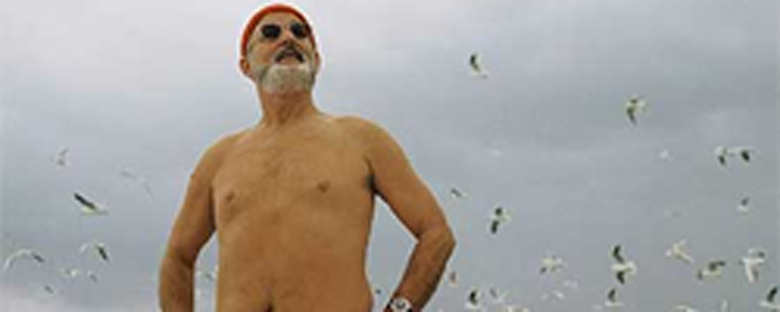Reviews
with Steve Zissou
Wes Anderson
USA, 2004
Credits
Review by Rumsey Taylor
Posted on 19 May 2005
Source The Criterion Collection DVD
Related articles
Features: Wes Anderson’s Tragic Comedy
Reviews: The Cousteau Odyssey
Screening Log: The Life Aquatic
Set in a customized Futura, The Life Aquatic’s title card confirms Wes Anderson’s employment of consistent aesthetic motifs, used in each of his films. These motifs are often solid indications of character; Max Fischer’s naïve ambition is denoted more in his beret than in his presumed lack of understanding of the French language, and Chaz Tenenbaum’s preparedness is relayed by his—and his sons’—red tracksuit. These meticulous and extensive production designs are attuned to the characters they house, complimenting them, a natural, if exaggerated proclamation of each character’s idiosyncrasy.
In this case, the chief stylistic signature is a red cap worn by oceanographer Steve Zissou and his crew. At exhibitions of the films the team makes of their research, at some ornate Italian opera house, the red caps become accessories to tuxedos. (This is not to mention the shades of blue that grace every costume or the customized Adidas.) What heart the film proposes is unaffectionate, because so much of the film is notably artificial. In a standout sequence, Zissou gives the viewer a tour of his boat, the Belafonte. He stands before a cross-section map, it is lifted and behind it is a full-size Belafonte, cut in half and inhabited by his crew—in a single shot, the camera tracks from room to room. It is a magnificent coup of filmmaking, but it serves to enhance this air of artificiality that enables The Life Aquatic’s standing as the lesser of Wes Anderson’s films to date.
Anderson’s earlier films contain many artificial aspects, but they are not distinguished by them. Each, also, is rooted by a character with some blind, selfish ambition, which remains largely unachieved in every case but this one. Anderson’s characters are endearing for their emotional scars, and how they hide them beneath these stubborn, idealistic notions of success and pride. The expedition led by Steve Zissou is built on the desire to avenge the death of one of his crewmen, felled by what he describes as a “jaguar shark.” In the footage screened from the troupe’s unfinished documentary, Zissou emerges from a dive in panic, surrounded by a well of blood. Surely, this is an affirming trauma for Zissou, but what utility this, and most every other scene retains to affect the viewer is restricted by the unusual amenities that are replete in every frame. In this case, Zissou’s combined fright and determination—relayed in a sporadic condition deemed “crazy eye”—become patronized in the exchange that meets his arrival on the surface:
Klaus: A shark bit him?
Steve: A shark ate him!
Klaus: It swallowed him whole?
Steve: No!… Chewed!
This conceit is of little criticism, as the film’s humor (specifically, Anderson’s trademark non-sequiturs) and production are so well-rendered. The creatures Zissou’s team discovers are all invented: a paisley octopus, the Crayon Pony Fish, and the aforementioned Jaguar Shark, each rendered in stop-motion animation. Successfully, the film employs a sense of discovery that is befitting; you’re eager to see what Zissou sees beneath the ocean’s surface. You just may not feel what he does.
We don’t do comments anymore, but you may contact us here or find us on Twitter or Facebook.



